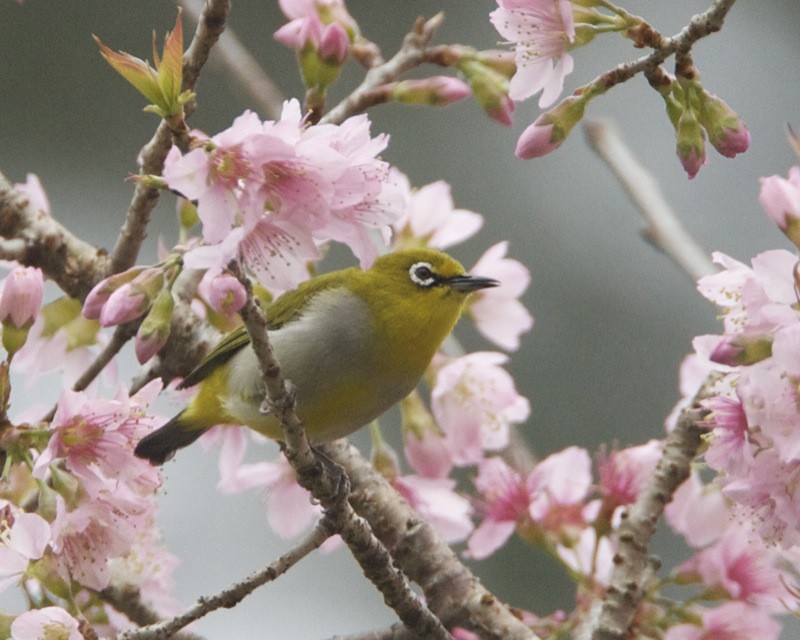Indian White-eye
A species of Typical white-eyes Scientific name : Zosterops palpebrosus Genus : Typical white-eyes
Indian White-eye, A species of Typical white-eyes
Botanical name: Zosterops palpebrosus
Genus: Typical white-eyes
Content
Description People often ask General Info
 Photo By Lip Kee Yap , used under CC-BY-SA-2.0 /Cropped and compressed from original
Photo By Lip Kee Yap , used under CC-BY-SA-2.0 /Cropped and compressed from original Description
This bird is small (about 8–9 cm long) with yellowish olive upper parts, a white eye ring, yellow throat and vent. The belly is whitish grey but may have yellow in some subspecies. The sexes look similar. The species is widespread and is part of a superspecies complex that includes Zosterops japonicus, Zosterops meyeni and possibly others. The taxonomy of the group is still unclear with some island populations being distinctive while some subspecies are not well supported. The population from Flores, Indonesia for instance is found closer to the pale white-eye. The family itself is now questioned since they are nested along with the Stachyris babblers. About eleven subspecies are well recognised. These include the nominate form (type locality Bengal, India) which is found from Oman and Arabia, Afghanistan, northern India and extends into China and northern Myanmar. The population in the Western Ghats and hills of southern India is placed in nilgiriensis while salimalii of the Eastern Ghats hills (Shevaroy, Chitteri, Seshachalam, Nallamalai) is sometimes subsumed into the nominate race. The population of the plains of India, Laccadives and Sri Lanka are sometimes placed in egregius (= egregia) but is restricted by other works to the population in Sri Lanka. The populations in southern Myanmar, Thailand and Laos are placed in siamensis. The Nicobar Islands form is nicobaricus and is sometimes also used for the population on the Andaman Islands which are however distinctive and a distinct unnamed population. The populations from southern Thailand to western Cambodia are placed in williamsoni. Other Southeast Asian island forms include auriventer (=aureiventer), buxtoni, melanurus and unicus. Race occidentis (now often subsumed into the nominate race) of the Western Himalayas has the upper side dark green and the flanks are tinged in brown. The form salimalii has a shorter bill and is brighter yellow-green above. Some authors consider the nominate race to be restricted to Sikkim, Bhutan, Assam and Yunnan and consider the peninsular race as occidentis (or amabilis if the form from Kathiawar described by Koelz is considered valid). In Sri Lanka, race egregia is smaller and has a brighter back and throat than the endemic Sri Lanka white-eye, Zosterops ceylonensis found in the central hills. 
Size
11 cm
Colors
Green
Yellow
Gray
White
Nest Placement
Tree
Feeding Habits
Indian White-eye has a varied diet, including insects, fruits, and nectar. It forages actively, adapting to diverse food sources and exhibiting a particular preference for flower nectar.
Habitat
The habitat of indian White-eye encompasses diverse forested regions, ranging from lowland scrublands and moist forests to mountainous terrains, up to 2,800 meters altitude. These birds thrive in environments like mangrove ecosystems, secondary growth areas, and broadleaved forests, as well as adapted urban settings such as gardens and plantations. Indian White-eye shows a preference for mid-elevational banj oak and chir pine habitats and can also inhabit large islands.
Dite type
Insectivorous
People often ask
General Info
Feeding Habits
Bird food type
Behavior
These white-eyes are sociable, forming flocks which only separate on the approach of the breeding season. They are highly arboreal and only rarely descend to the ground. The breeding season is February to September but April is the peak breeding season and the compact cup nest is a placed like a hammock on the fork of a branch. The nest is built in about 4 days and the two pale blue eggs are laid within a couple of days of each other. The eggs hatch in about 10 days. Both sexes take care of brooding the chicks which fledge in about 10 days. 
Distribution Area
The species is found in a wide range of habitats from scrub to moist forest. They sometimes occur on mangrove areas such as in the Karachi area. and on islands they may lead a more insectivorous life. They are somewhat rare only in the drier desert regions of western India. A feral population was detected in San Diego, California in the 1980s and subsequently eradicated. 
Species Status
Not globally threatened.